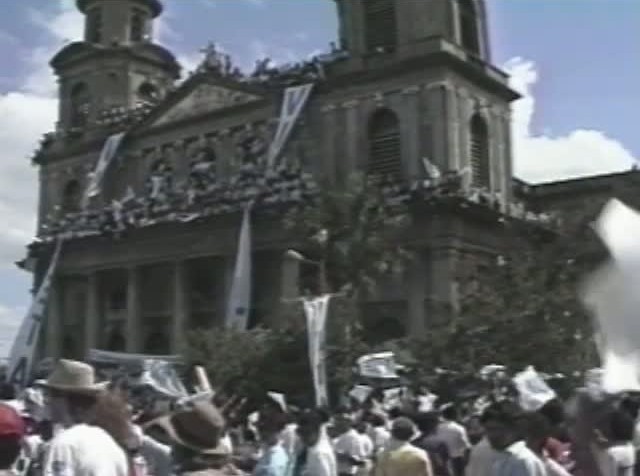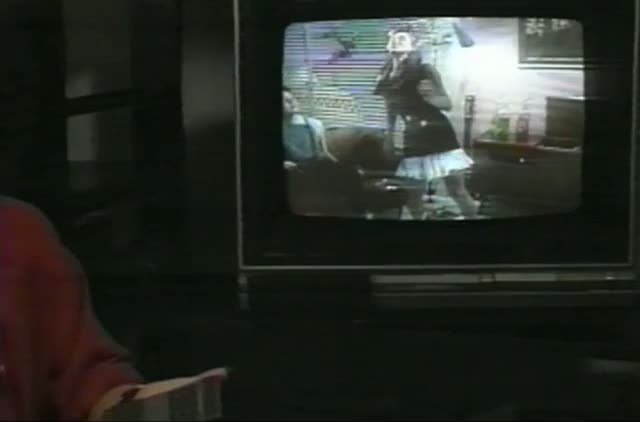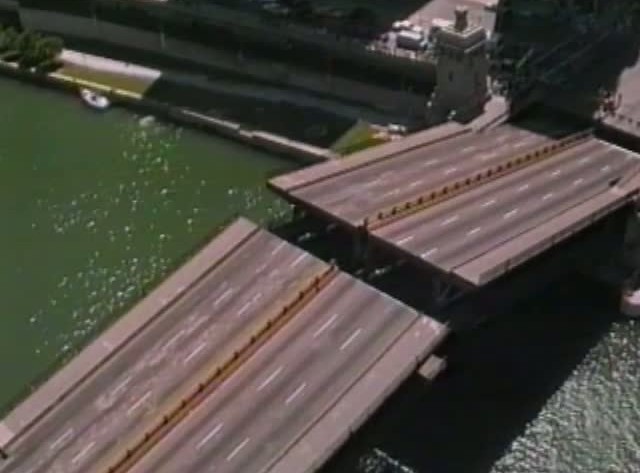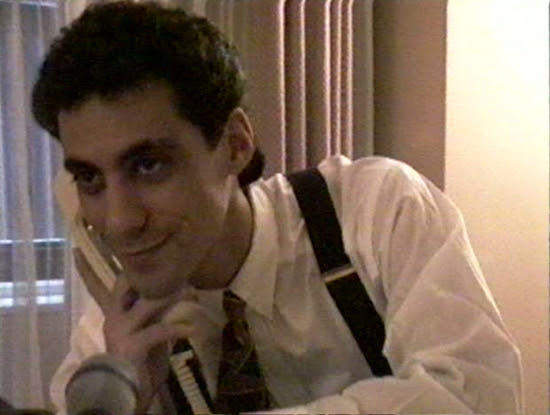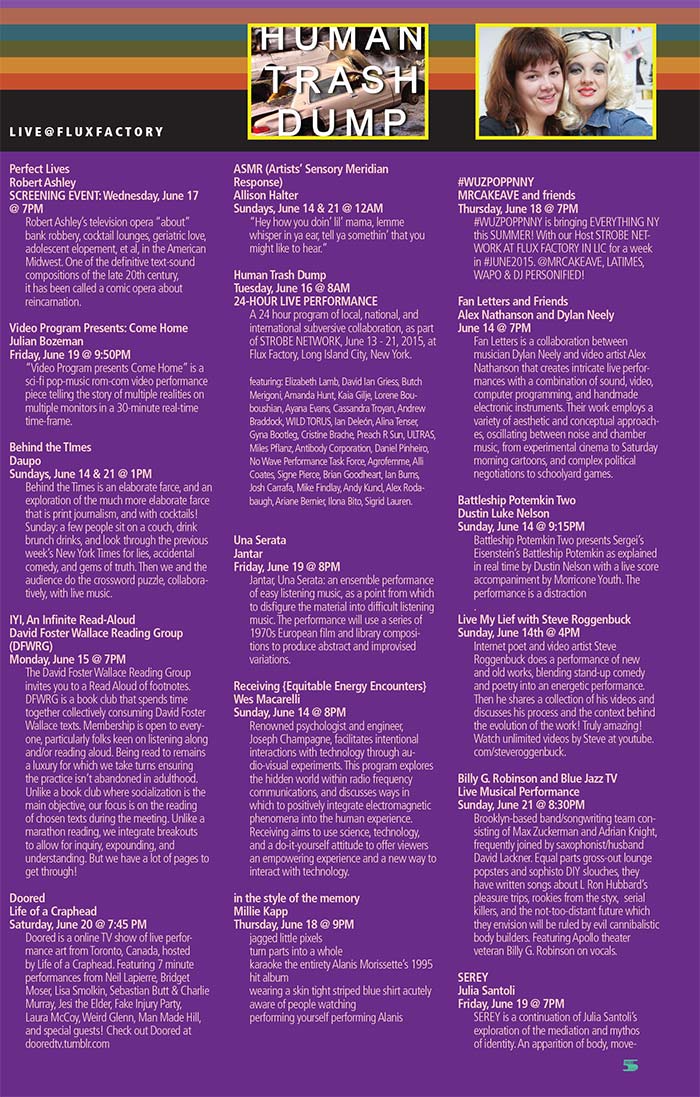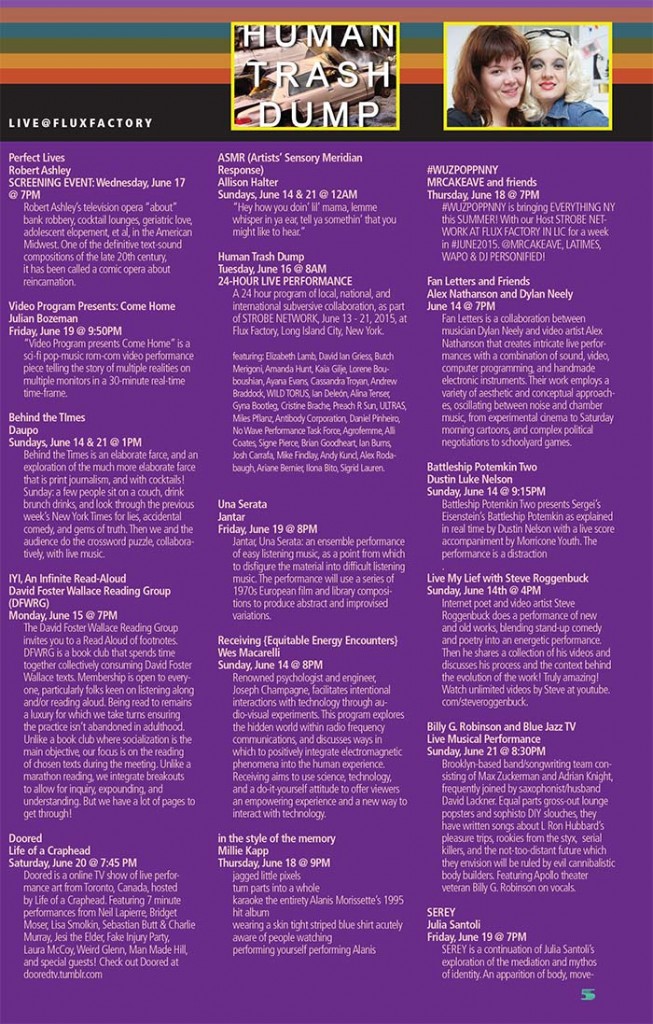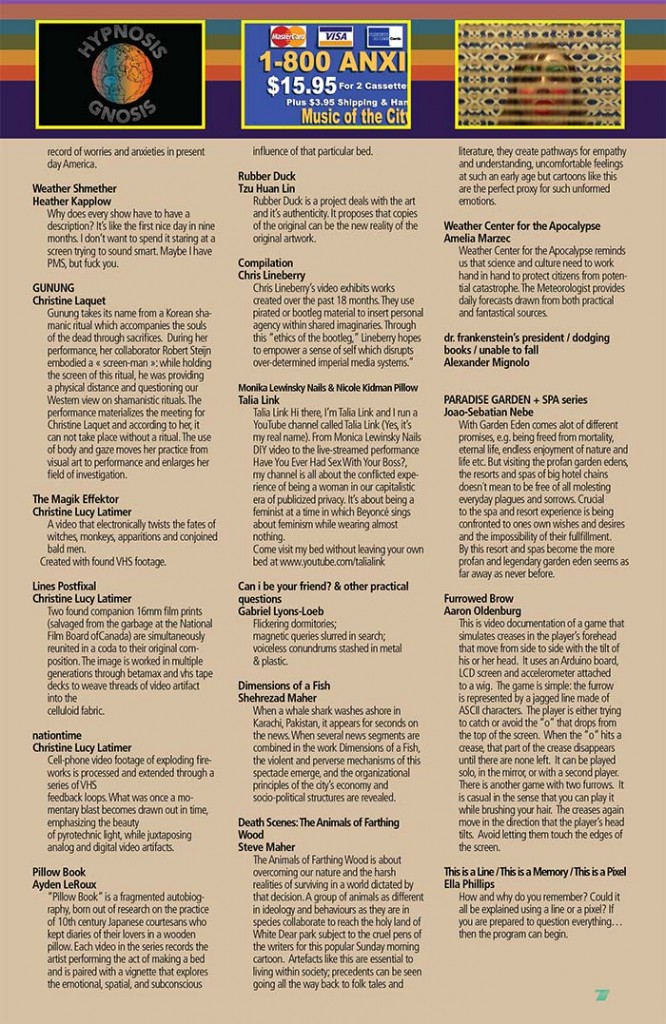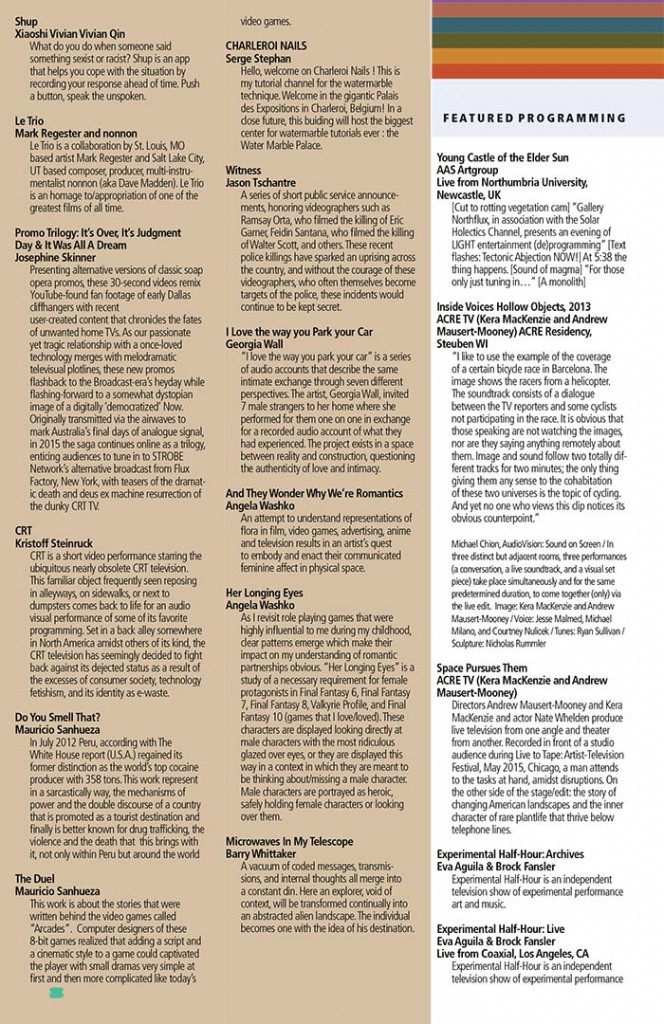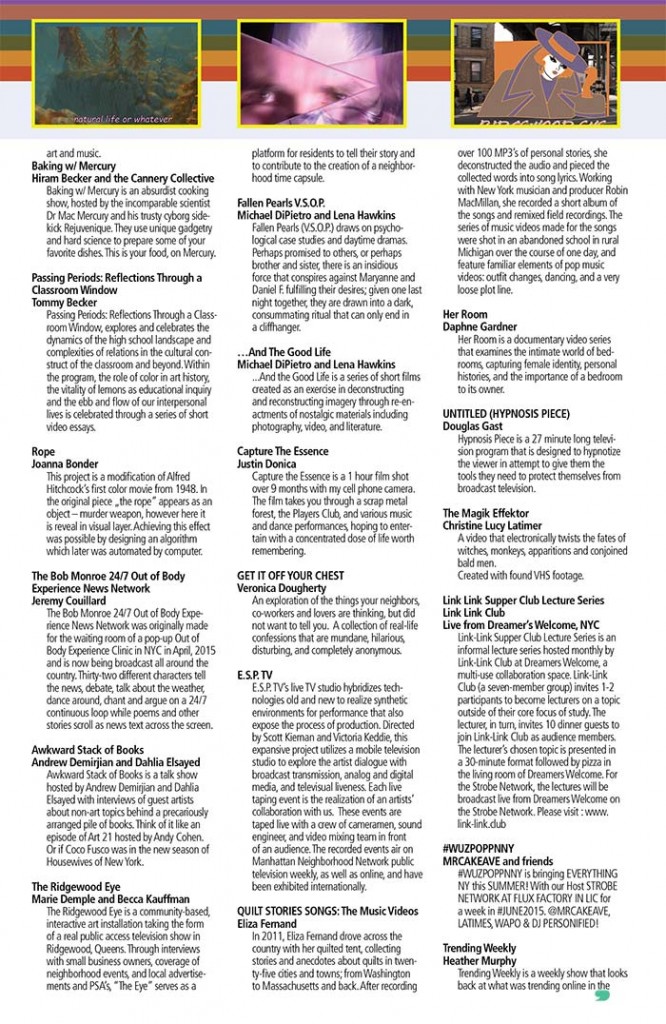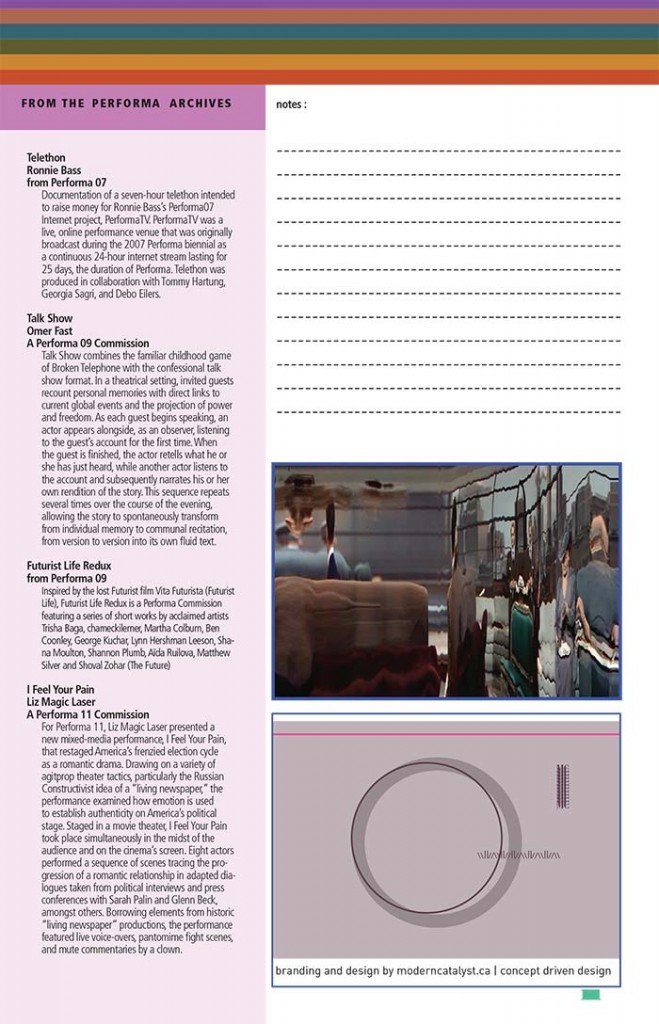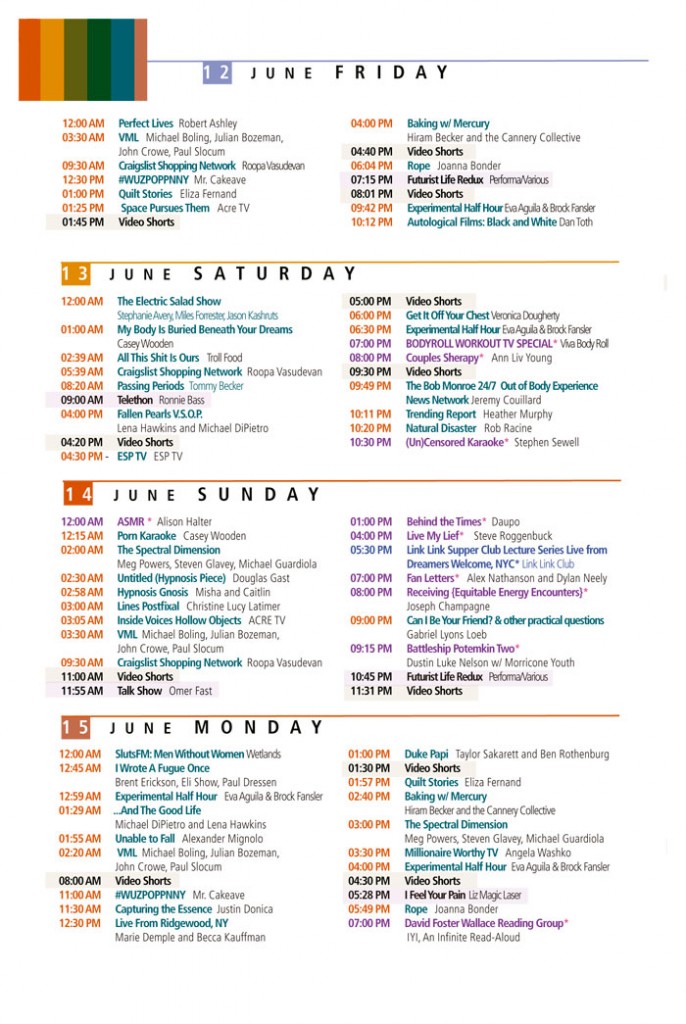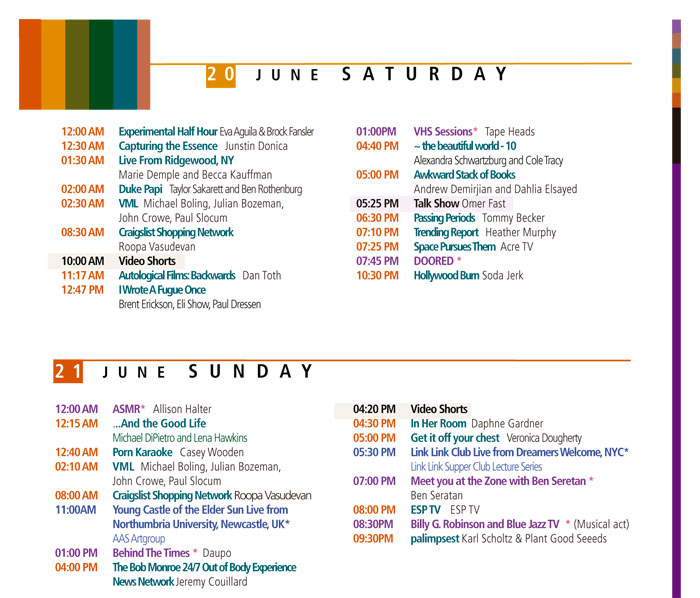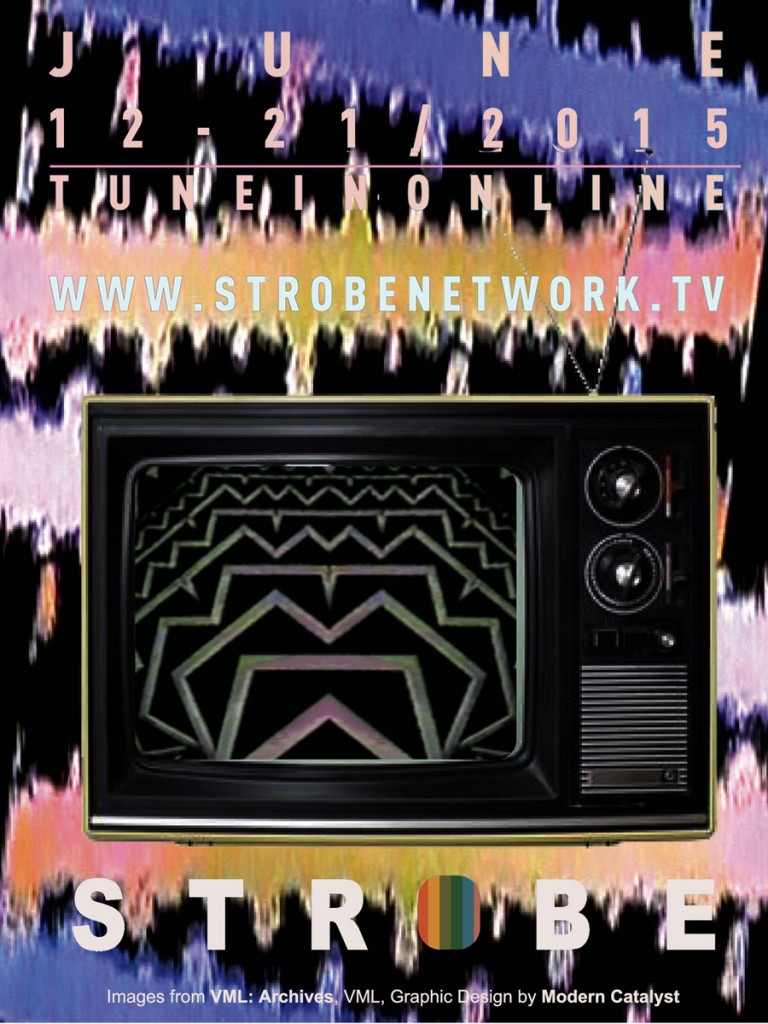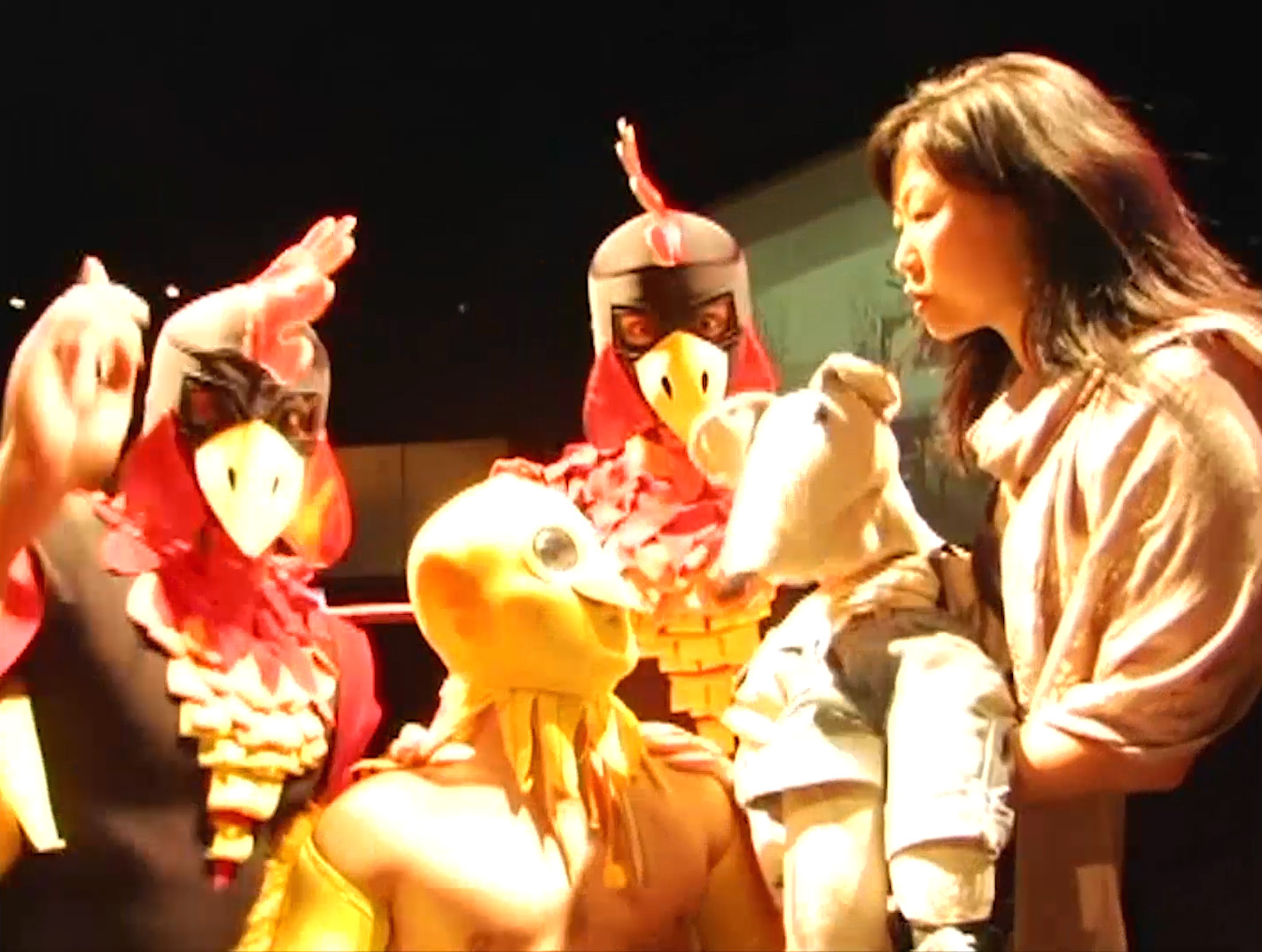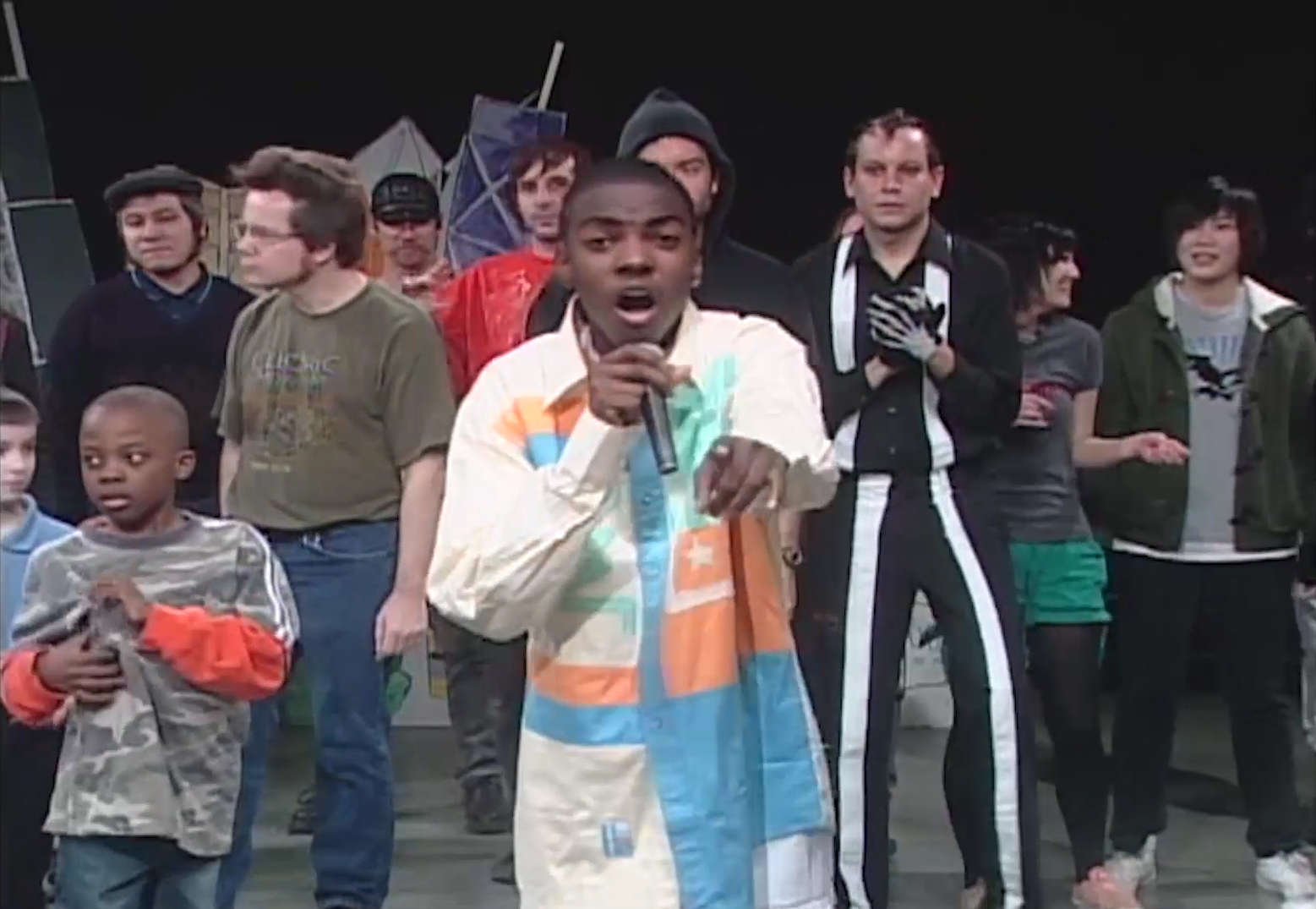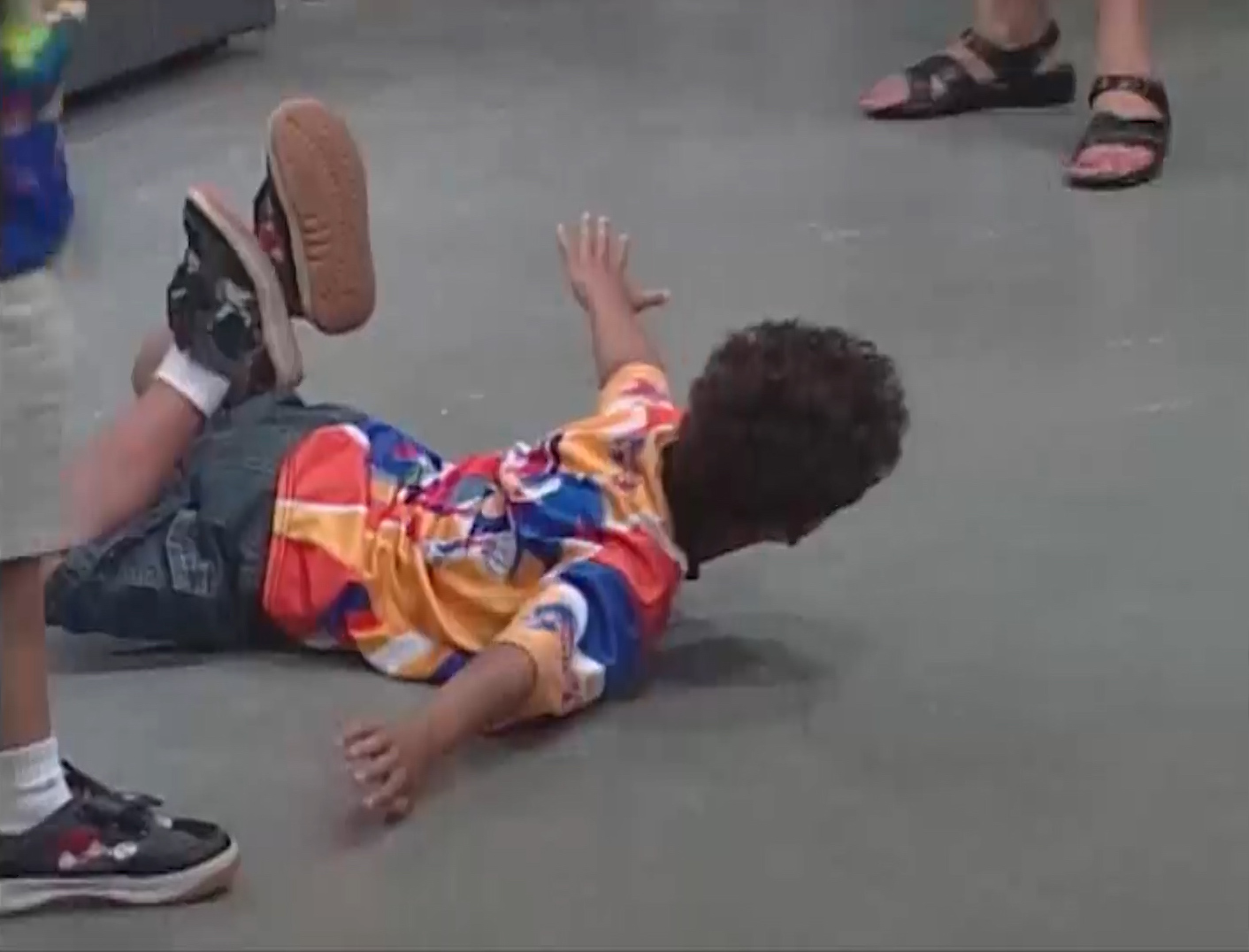Streaming June 24th: Episode 201 – 207
Episode 201: TV Culture And How It Affects World Views (12am, 7am, 2pm, 9pm CDT)
Episode 201 of the award-winning TV series The 90’s. This episode is called “TV Culture And How It Affects World Views” and features the following segments:
00:00 Color bars.
00:47 The 90’s Opening.
02:02 “Covering the Coverage: The 1990 Nicaraguan Elections” by Bob Hercules. A Chicago TV crew travels to Managua and reports on U.S. television journalists’ coverage of the historic elections. NBC’s Jane Whitney: “I’m scared by reporters misconception, preconceived ideas, frames of reference… if you’re only getting your news from TV… you’re not getting your news.” Photojournalist: “There’s problems communicating here…reporter’s contacts aren’t good, there’s political baggage and it’s tough to see the other side of the coin…”
08:48 “TV Addicts” by The Media Foundation. A PSA for the Media Foundation urging parents to monitor children’s TV habits.
09:02 “Todd Alcott” by Skip Blumberg. Another rant from 90’s regular, Todd Alcott. Todd speaks as a TV. “Look at Me… Look at me!!” “People try to tell you that I’m bad for you… you tell them I’ve been here through thick and thin, 110% of the time!… You’ll get crime, thrills, sex, right here, all in the next 8 minutes… it’s miracle… look at me… look AT ME!!!”
10:51 “Video in the Villages” by Vincent Carelli. For the past two years South American Indian tribes have used video cameras to record their ceremonies and events in an effort to increase communication between tribes and to preserve ancient traditions that are in danger of being forgotten.
16:00 “Kids TV.” A group of grade six students from Chicago take part in Panasonic Corp’s video contest and make their own television newscast.
17:41 “Revolution: What a Crock” by John Walden and Paper Tiger TV. A critique of Ted Koppel’s recent report on the increased use and influence of home video on television news. “It’s the same old thing… Ted and Co. trivialize images, render them empty of meaning an maintain control of the message which doesn’t encourage us to be active, which doesn’t empower us to take part in the world around us. It’s the same old stuff in a brand new box… under the pretense of telling us something new.”
24:23 “Free Speech” by Skip Blumberg. On the streets of New York City, a spokesman attracts a crowd with his advice to blacks and Latinos to avoid assimilation and support only black and Latino businesses. A white policeman tries to disperse the crowd but is denounced: “The man has a right to voice his opinions, and we have a right to listen!”
30:07 “Popeye the Sailor Man” by Eddie Becker. At the Earth Day celebrations in Washington, D.C., Popeye joins the ecology movement. “I’m Popeye the sailor man, I recycle my spinach can… Anyone who pollutes the air, earth, or ocean is nothing more than a criminal!”
31:47 “It’s Television ” by TVTV. A spoof of early TV in the U.S. in the early 1950’s. A middle class family gets their first TV and the whole neighborhood comes to watch. “Sit back and light up a Camel.”
34:40 “Dee Davis” by Appalshop. Davis comments on TV: “The problem with television is that programming is developed to sell things. TV should change people’s lives, should offer new enthusiasm, should make the lame walk and the blind see.”
35:16 “Don Cherry” by Starr Sutherland. A musician at the Victoria Theater in San Francisco plays a 3 in 1 instrument: a kazoo, a “Jew’s harp” and a clicker.
36:49 “The Today Show” by Nancy Cain. Cain observes a live outdoor taping of The Today Show in Venice Beach, California. We see Bryant Gumbel and Frank Zappa, Jay Leno visits a falafel stand and attracts a crowd.
40:29 “Selling Gold” by Skip Blumberg. On Chambers and Broadway in New York City, a street vendor sells gold jewelry.
41:05 “Cutaways” by R.D. Rosen. A comedic piece in which Rosen demonstrates how to shoot cutaways, a TV production trick to cover jump cuts in an interview. The camera records the interviewer pretending to listen intently, looking doubtful, mildly astonished, etc. He also shows us the wrong way to appear in the cutaways: nodding off to sleep, flossing your teeth, etc.
43:13 “Export TV: Anatomy of an Electronic Invasion” by Monica Melamid. A short documentary about TV Marti, a U.S. broadcast from Key West, FL aimed at the people of Cuba. Its mission is broadcast anti-Castro propaganda in order to influence Cuban public opinion.
48:13 “The Surf Report” by Nancy Cain. It focuses on a Misha, a street vendor on Venice Beach. Originally from the Soviet Union, Misha sells “Gorby” T-shirts on Venice Beach and sings a song.
49:40 “Nestle Quick Commercial.” A ventriloquist and his dog, Farfel, sell Nestle’s instant chocolate.
50:34 “First Anniversary of Tompkins Square” by Marcel Lacroix. One year after homeless people are evicted from a NYC park, another confrontation occurs when people gather to commemorate the anniversary. Police force the homeless to leave the park, so they move to the street, then are forced to leave the street and go back to the park. A portrait of this clash with authority.
54:13 “Contrasts” by Lillian Liberman. We see the contrast between the wealthy and the poor in Mexico City.
55:47 Music video for the song “The Human Race” by Aashid. He sings about the sorry state of the human race: “What’s wrong with men living in this world… maiming and killing and raping little girls…”
56:20 End credits begin over Aashid.
Main Credits:
executive producer, Tom Weinberg; producer, Joel Cohen; chief bureaucrat, John Schwartz; editors, Mirko Popadic and John Grod; outreach producer, DeeDee Halleck; 90’s Video Correspondent reports: “Free Speech,” “Todd Alcott as TV,” and “Gold in the Streets” by Skip Blumberg; “The Today Show on Venice Beach,” and “Misha- The Russian Capitalist” by Nancy Cain; “Popeye” by Eddie Becker; “Don Cherry” by Starr Sutherland; 90’s correspondents, Appalshop and Esti Marpet; “Covering the Coverage” by Bob Hercules, Frank Dina, Rich Pooler, Sue Ranft and Felice Levin; “TV Addicts” The Media Foundation; “Video in the Villages” produced by Centro de Trabalho Indigenista, Sao Paolo, Brazil; “Revolution: What a Crock!” by John Walden and Paper Tiger Southwest; “The Human Race” by Aashid; associate producers, Joe Angio and Ricki Katz; production administrator, Linda Schulman; business affairs, Eric Kramer; network builder, Jonathan Cohen; video production, Pat Creadon and Jim Morrissette; Voices of THE 90’s, Ricki Katz and Joe Cummings; Faces of THE 90’s, Kristin Graziano and Jesse Weinberg; special thanks, Steve Atlas, Herb Channick, David Halberstam, Ida Jeter, Hye Jung Park, Sandra Salazar, Studs Terkel, Willie Walker and DCTV
Additional Credits:
paintbox, Rich DuCasse; major collaborator, Scott Jacobs; titles & effects created at Independent Programming Associates; opening sequence produced by John Anderson; opening film sequence by Tom Finerty; original music by The Cleaning Ladys; for KBDI, director of programming and production, Diane Markrow; post-production facilities, The Center for New Television, Chicago; funded in part by The John D. and Catherine T. MacArthur Foundation and Instructional Telecommunications Foundation, Inc.; copyright 1990 The Center for New Television
Episode 202: How We Get Around (a.k.a. The Taxi Show) (1am, 8am, 3pm, 10pm CDT)
Episode 202 of the award-winning TV series The 90’s. This episode is called “How We Get Around (a.k.a. The Taxi Show)” and features the following segments:
01:06 “New York Cabbie” by Skip Blumberg. Robert Demella, a NYC cab driver, rants about various subjects. On how to avoid getting scammed: “You don’t pick up drunks, teenagers or seedy types.” On TV: “Only good for news…I’d like to take a sledgehammer and smash the TV…The TV set is the downfall of Western Civilization…People don’t read anymore, people don’t talk anymore, people don’t think anymore…Our generation that grew up on TV is probably the STUPIDEST generation to come down the pike.”
05:11 “Time Lapse Traffic” by Spectra Motion. Time lapse photography of San Francisco traffic.
06:02 “Los Angeles Cabbies” by Jay April. Various cabbies are interviewed about traffic in L.A. April finally gets in one cab, managing to have chosen a rather crazy person for a driver. This cabbie reports on his discovery of the password to the human mind, the word “isos,” which means “equal to.” He expounds on his philosophy of life based on the concept of isos.
09:09 “Pat and Alice” by David J. Hollander and Jay David Cookson. A couple recounts their UFO experiences. The woman claims aliens took her unborn child.
11:43 More “Los Angeles Cabbie.” The cabbie integrates scientific formulas into his description of his philosophy.
13:12 Todd Alcott performance by Skip Blumberg. The 90’s regular Todd Alcott rants about whether he should be concerned more about global warming or an ice age.
14:55 “Taxi – Mambo” by Lillian Liberman. Shots of taxis in Mexico City edited rhythmically to mambo music. Very colorful VW bugs and dense traffic.
16:25 More “Los Angeles Cabbie.” “L.A. is getting a subway system. It’ll alleviate traffic problems.”
16:53 William Armento commentary by Nancy Cain. Armento, a L.A. subway designer comments on the growing need for cities to have viable subway systems. “We are running out of fossil fuels…people may not be able to use their automobiles…subways run on electrical power which is more plentiful that fossil fuels…Solar and wind power? Not sufficient for a subway system, but perhaps could power a golf cart…”
18:47 “Solar Cars” by V. Ndolo Dombe and Sergei Franklin. Solar Powered automobiles race in Switzerland.
22:18 More “New York Cabbie.” Demella continues to rant: … “It feels like we’re on the verge of a new Dark Ages…the Roman Empire circa 573 AD…instead of the Mongols and the Huns we have the Japanese and Koreans from the east with video cameras, tape decks, camcorders and TVs…”
23:19 “Outrageous Taxi Stories” by Joe Berlinger. A young woman tells a story about her cab ride to Brooklyn: The cab driver pulls a dead fish from a toilet in the passenger seat of the cab and says, “This is what happens when you take something out of its environment… it’s cold blooded and it has no soul!” She pays him quickly and gets out of the cab and notices the license plate – “Hell of a Taxi”.
27:25 “Unsettling the Frontier” by Jim Likowski. A video commentary on how the railway brought progress to a town.
30:11 “1950s Chevrolet Commercial.”
31:30 “Pan Am Flight #11” by Skip Blumberg. On a flight from Frankfurt, Germany to New York, the pilots show us aerial maps and discuss jet lag.
33:48 “Shadow Traffic.” A piece about Shadow Traffic, a Chicago traffic reporting service. A man advises us that “traffic is a variation on a theme…it’s the same thing everyday.”
35:03 Excerpt from “Once a Star” by Tom Weinberg and Joel Cohen. “Once a Star” was a show profiling former professional athletes. This segment focuses on Nathaniel “Sweetwater” Clifton, former NBA player who broke the NBA color barrier. Today (in his 60’s) he drives a cab in Chicago. He has no pension and no bitterness, claiming only that “the U.S. is a great country.”
39:39 More “New York Cabbie.” Demella: “I have a Buddhist approach to cab driving…I don’t look for fares, fares find me.” “You don’t let it get to you. If you do, you’ll be homicidal in two months on this job…”
40:26 “Hobo” by Tom Finerty. Excerpt from the Emmy Award winning documentary that examines the quickly vanishing vagabond culture in the United States. The song “Big Rock Candy Mountain” plays from radio HOBO over close-ups of various hobos and passing landscapes.
43:38 More from “Outrageous Taxi Stories.” A cab driver tells a story of how he performed beyond the call of duty. A tearful woman gets into his cab with a sad love story. She had recently broken up with her boyfriend after he asked her to marry him, a move she now deeply regrets. The cabbie managed to reunite the lovers and was subsequently invited to their wedding.
45:47 “Cars and Owners” by Chip Lord. Lord interviews Skip Blumberg about his new 1978 Plymouth Valiant. Skip: “I like this car because it looks very normal and regular…I don’t care too much for cars, really…As long as it works and I don’t hate it, it’s fine.” He talks about how he decided to buy the car and has us listen to the engine. At the end, he has us look in the trunk – “You know what I keep around here – my real set of wheels!” and rolls away on his roller skates.
42:26 “The Motorist” by Chip Lord. A man recounts his earliest memories about cars over dream-like images.
49:37 “1960 Edsel Commercial”
50:33 “1960 Presidential Campaign Ad: Nixon.” Nixon talks to us onscreen about his abilities to defend America. “America’s defenses should be strong enough to keep us out of the war, powerful enough so that Communists know that we can’t be pushed around.” “Vote for Nixon and Lodge – they understand what peace demands.”
51:35 More “Outrageous Taxi Stories.” “Most cab drivers are professionals. When a guy drives a cab 6 or 7 days a week, 12 hours a day, you gotta learn something.”
51:55 “Washington DC Cabbie” by Eddie Becker. Becker asks: How do you handle people in taxis? Cabbie: “You agree with whatever they say…there’s no tip if you make them mad.”
53:08 More “New York Cabbie” (this time the piece is by Esti Marpet). Demella continues: “There’s no short term fixes on any problems in New York City…I hate quick fixes, I hate sound bytes, I can smell a fraud a mile away…if a fare is overly friendly…he’s got no money.”
55:33 More “Los Angeles Cabbie.” “Traffic in L. A. is okay weekends, impossible during the week…A cab is a one room schoolhouse…I sell you a ride and we talk.”
55:53 End Credits.
58:04 30 second promo.
58:47 Another 30 second promo.
Main Credits:
executive producer, Tom Weinberg; producer, Joel Cohen; chief bureaucrat, John Schwartz; editor, John Grod; outreach producer, DeeDee Halleck; “Cab Ride with Robert Demella,” “Todd Alcott,” and “Cockpit” by Skip Blumberg; “William Armento” by Nancy Cain; “D.C. Cab Ride” by Eddie Becker; “More with Robert Demella” by Esti Marpet; 90’s correspondents, Appalshop, Starr Sutherland; “Time Lapse Photography” by Spectra Motion Pictures, Eugene, Oregon; “L.A. Cab Ride” by Jay April; “Outrageous Taxi Stories” by Joe Berlinger; archival commercials courtesy of Video Data Bank; associate producers Joe Angio and Ricki Katz; production administrator, Linda Schulman; business affairs, Eric Kramer; station relations, Jonathan Cohen; video production, Pat Creadon, Jim Morrissette and Shu Lea Cheang; Voices of THE 90’s, Joe Cummings and John Mengelt; production assistance, Natalie Frutig
Additional Credits:
paintbox, Rich DuCasse; major collaborator, Scott Jacobs; titles & effects created at Independent Programming Associates; opening sequence produced by John Anderson; opening film sequence by Tom Finerty; original music by The Cleaning Ladys; this program inspired by Tony Schwartz and his Folkways Records “That’s My Opinion…and I’m Right.”; for KBDI, director of programming and production, Diane Markrow; post-production facilities, The Center for New Television, Chicago; funded in part by The John D. and Catherine T. MacArthur Foundation and Instructional Telecommunications Foundation, Inc.; copyright 1990 The Center for New Television
Episode 203 (2am, 9am, 4pm, 11pm CDT)
Episode 203 of the award-winning TV series The 90’s. This episode features the following segments:
0:24 Cold open with Johnny Marijuanaseed.
0:52 The 90’s opening.
01:33 “Johnny Marijuanaseed” by Nancy Cain. Johhny Marijuanaseed, a hemp activist, tells Nancy Cain: “It was William Randolph Hearst who was instrumental in outlawing hemp. A newspaper baron, Hearst was concerned that newsprint manufactured from a hemp byproduct would interfere with his immense profits from the enormous tracts of forest that he owned…In 1937 Hearst along with DuPont and Mellon were instrumental in the passage of the Marijuana Tax Act, which made the growing of hemp illegal in the U.S. At the time the AMA fought the legislation arguing that hemp is a useful medicinal plant…”
05:00 Interview with Gatewood Galbraith, Democratic gubernatorial candidate from Kentucky and marijuana advocate. “Reagan and Bush are not conservatives, they’re aliens…I believe that marijuana should be licensed and regulated as a cash crop and let our farmers make this money…When I was growing up, conservative meant you kept the government in the box…The government does not have the right to interfere in alot of different aspects of people’s lives in this state. Marijuana is a benchmark topic for this election… A society that can accommodate tobacco and alcohol should accommodate marijuana… The government, if not controlled, will grow to occupy the space currently occupied by our civil liberties…”
09:11 “Hash Bash 1990” by Doug Susalla & Bill Kubota. At the University of Michigan in Ann Arbor students demonstrate for looser marijuana laws. A spokesman for NORML says that the problem is with the government ‘s drug policy, not with the drugs themselves. We are told that less than 1% of the American public is addicted to drugs. Gatewood Galbraith says that “the government knows that marijuana doesn’t make you crazy or lead to other drugs.” Bystanders express disgust at the pot smokers, who are by and large completely incoherent.
13:58 “P.O. Park Ranger” by Robert Hanson. A satire of a severe, forceful park ranger who reminds us of a few park policies: “no running, no tomfoolery, no drugs, no herb, no shake, no flake…”
14:44 Richard Dennis, chairman, Advisory Board Drug Policy Foundation, speaks: “The current drug policy is doing kids a disservice… it’s saying that all drugs are the same and it’s setting up kids to have endless doubts about what authority figures say if they can be trusted. Minority neighborhoods are being used as staging zones for drug warriors to attack dealers in order to protect people in the suburbs from themselves… the War on Drugs is regressive.”
15:50 “Cook County Prison.” In Chicago, a group of singers made up of inmates and guards entertain prisoners.
18:09 “Tom McKean” by Joel Cohen. Ex-cocaine addict McKean does open line radio and talks to school kids in Chicago’s inner city about how to avoid peer pressure and drug use. He says that “government is not the answer, prison is not the answer, rehabilitation is the answer…The reason we do drugs is because we live fast-paced lives and we have needs and we don’t know what to do…Kids need to be loved off drugs.”
24:07 “Hon. Robert Sweet” by Esti Marpet. N.Y. Judge Robert Sweet speaks: “In 1972, a committee reporting to Nixon recommended marijuana be legalized…The National Academy of Sciences made the same recommendation a few years ago. Growing marijuana is the second largest cash crop in California. The American people have learned that the threat of ‘reefer madness’ is nonsense…If we want to be practical we have to realize that 75% of arrests in the criminal justice system are marijuana arrests…If we eliminate prohibition of marijuana we will ease the burden on the criminal justice system.”
26:31 “Dead Are Not Dead” by Judith Binder. A Venice Beach musician sings: “Our spirit lives on and on, in the trees, in the water, in the fire that’s dying.”
28:11 More from “Johnny Marijuanaseed.” Johnny tells us that no other plant has as many byproducts as hemp and is as good for the environment. “You can make fabric from it, you can make paper from it, you can make gas and electricity. It’s organically grown…it could replace fossil fuels.”
30:12 More from Gatewood Galbraith, smoking marijuana as he speaks: “The problem is that the pharmaceutical and petrochemical industries control this country. Hemp is the greatest product. Hemp IS petroleum. It’s no coincidence that in 1937 when hemp was outlawed, nylon was patented. The true battle on this planet today is between the naturals and the synthetics.”
32:57 “Don’t Go in the Basement” by Sally Cruikshank. An animated music video.
34:14 Tony Serra commentary by Jesse Drew. Serra, a civil rights lawyer, talks about the legalization of marijuana: “The truth is that marijuana is more benign than alcohol and tobacco put together. Marijuana should be legalized. There is no nexus, no stepping stone between marijuana and shooting heroin. Total prohibition has created the drug problem.”
35:55 “Surveillance in Los Angeles” by Aron Ranen. A documentary about the various forms of surveillance in and around L.A.
38:59 “Mayor Barry” by Gross National Product. An “electronic cartoon.” A photo of Barry is in a frying pan, an egg is cracked into the pan and fried, ala the famous 1980’s anti-drug campaign. “This is Mayor Barry…on drugs…Why do you think it’s called the District of Columbia?”
39:17 “Don Fielder” by Eddie Becker. Fielder, the Executive of NORML, speaks: “William Bennett is a dangerous man…anyone who speaks out against his drug policy is considered unpatriotic. The drug problem is an issue for the Surgeon General, not the Attorney General. Bennett’s solution is to create more prisons, more jails and take away our constitutional freedoms.”
40:59 “Wavy Gravy” by Pat Creadon. At Weedstock in Black River Falls, Wisconsin, Wavy Gravy, the perennial countercultural figure, speaks about legalizing marijuana. He says: “Let’s get real, herb should be legalized, I’m tired of my friends getting put away for smoking a little herb. Part of my spiritual life is smoking herb.” “The 90’s are the 60’s standing on their head.”
42:49 An excerpt from the documentary “Chef Ra Escapes Babylon” by Scott Kennedy/High Times Video. Chef Ra escapes fast-paced city life and flees to Jamaica. The Rastafarian chef takes us on a tour of a Ganja field. “Herb is different from cocaine and heroin. It is a blessed plant that could give you a little happiness.” He complains that the U.S. drug policy is hurting the Jamaican economy.
48:17 More from Richard Dennis: “I don’t see what law enforcement does except add to people’s misery. It makes no sense. If I could have a ‘wish list’ of drugs to outlaw, the first would be crack, the second, tobacco. We should never talk of crack and pot in the same paragraph.”
48:45 “Earth Day 1990: Washington DC” by Eddie Becker. Members of NORML sell clothing made of hemp. According to them, “Hemp is the only biomass capable of making America energy independent. One acre of pot equals four acres of trees grown for paper production. Hemp can be grown in any soil, it has no enemies. The only enemy is the U.S. Government. Smoking pot is good for you – it lowers stress, dilates the arteries and lowers your body temperature. Smoke pot – you’ll live longer!”
51:26 “Father Guido Sarducci” by Don Novello & Willie Walker. 1970s Saturday Night Live character Father Sarducci returns to appear on the 90’s: “Marijuana is no longer under the patron saint of hard drugs, it’s changed. It’s now under the patron saint of beer and wine.”
53:02 “The ‘Pope” by Esti Marpet. From Greenwich Village in New York City, a man claims: “I am the pope, self appointed. Marijuana can save the world. You can make clothes out of it, it grows quickly, it conserves soil. It’s the only safe drug.”
54:41 More from “Johnny Marijuanaseed”: “Everything you can make from whale oil, you can make from hemp oil. You can process and texturize hemp into tofu… we could save the Whales!”
55:53 End Credits.
57:36 30 second promo.
Main Credits:
executive producer, Tom Weinberg; producer, Joel Cohen; chief bureaucrat, John Schwartz; editor, John Grod; outreach producer, DeeDee Halleck; “Johnny Marijuanaseed” by Nancy Cain, Johnny Marijuanaseed (played by Chris Conrad); “Don Fiedler” and “Earth Day, D.C.” by Eddie Becker; “Judge Robert Sweet” and “The Pope” by Esti Marpet; 90s correspondents, Skip Blumberg, Starr Sutherland, Appalshop; “Tony Serra” by Jesse Drew; “Chef Ra Escapes Babylon” by Scott Kennedy, High Times Video, music by Pray for Rain; “The Dead Are Not Dead (Venice Beach Musician)” by Judith Binder; “Wavy Gravy” by Pat Creadon; “Father Guido Sarducci” by Dan Novello & Willie Walker; associate producers Joe Angio and Ricki Katz; production administrator, Linda Schulman; business affairs, Eric Kramer; network builder, Jonathan Cohen; video production, Pat Creadon, Jim Morrissette and Eric Kramer; Voice of THE 90’s, Tony Judge; Faces of THE 90’s, Kristin Graziano and Jesse Weinberg; special thanks, Tony Fitzpatrick, Louie Fiala, Ida Jeter, Dee Davis and WLUP Radio
Additional Credits:
paintbox, Rich DuCasse; major collaborator, Scott Jacobs; titles & effects created at Independent Programming Associates; opening sequence produced by John Anderson; opening film sequence by Tom Finerty; original music by The Cleaning Ladys; for KBDI, director of programming and production, Diane Markrow; post-production facilities, The Center for New Television, Chicago; funded in part by The John D. and Catherine T. MacArthur Foundation and Instructional Telecommunications Foundation, Inc.; copyright 1990 The Center for New Television
Episode 204: Around The World And On The Edge (3am, 10am, 5pm CDT)
Episode 204 of the award-winning TV series The 90’s. This episode is called “Around The World And On The Edge” and features the following segments:
01:59 “Africa” by Kathy Faul. A hot air balloon ride over Kenya. We see wildebeasts, zebras, baboons, wild boars, giraffes, leopards (enjoying a fresh kill), elephants and lions. Set to pulsing electronic music.
06:10 “Village in Irian Jaya” by Mary Lou Witz. A home video shot by Witz, an American psychologist, while on vacation in Indonesia. In a tribal village the women work in the fields and carry produce to the market while men sit around and smoke. Witz claims that the reason for this is that the men pay between seven and twenty pigs for a bride, so the women must repay them in labor. We watch villagers slaughter a pig, start a fire by rubbing a piece of rattan between two twigs, and roast a pig in honor of a visitor.
08:37 “Nicaraguan Baseball” by Joe Angio. At the Stanley Cayasso Baseball Tourney in Managua we watch pre-game food preparation, baseline chalking, and we meet Keith Wesley Downs, a bat boy who brings his team good luck by dancing around each base with a baby doll.
11:44 “I Lost My Love at the Demolition Derby” by Richard Watrous. We follow a novice driver and his Mercury Comet as he prepares for the demolition derby competition at the Durham, North Carolina State Fair. He asks: “What do you have to do to qualify?” The answer: “All you have to be is stupid!” Unfortunately, our hero’s car does not survive the event. With the help of some video effects, we watch the car’s soul float up to heaven.
18:01 “Moscow Artists” by Skip Blumberg. Blumberg visits the Russian countryside with the director of the Institute of Contemporary Art in Boston. They participate in a ceremony honoring the independence of “nonofficial artists.” Paintings are lined up in the snow and then thrown into a river as a symbol of artistic freedom. David Ross is the organizer.
23:41 “Moscow Violinist” by Skip Blumberg. At a Russian dinner celebration, many people sit at a table with a huge array of food, drink and noise. They are entertained by a stunt violinist who is able to continue playing no matter how his body is contorted.
27:06 “President George H. W. Bush in Oakwood, California” by Nancy Cain. Bush visits this coastal neighborhood to bestow an award while residents protest over the lack of subsidized housing in the area. We meet a woman who lives with her grandmother because she can ‘t find affordable housing for herself and her three kids. This reality contrasts greatly with the extreme level of security observed by the President and highlights his distance from the real problems of the American people.
33:34 “A Visit to a Collective Apartment” by Skip Blumberg. Four families and an old woman share a flat in Moscow. Blumberg investigates how the close living quarters affect the people involved.
37:08 “International Football League” by Gross National Product. A satirical look at world political affairs. Sports announcers describe the results of various “games” between countries.
39:50 “Burmese Guerrilla Training” by Andrew Jones. At Thy Baw Bo Pass at the Burma/Thailand border, the Karin Guerrillas are training. For the past forty years they have been involved in a Civil War against Burma’s military government. Since the military takeover of September 18, 1988 they have been joined by Burmese students who are training in combat technique with the hope of establishing underground movements to overthrow the current regime and establishing true democracy. A spokesman describes the training and the students’ regular nonviolent demonstrations. He explains that the military government does not tolerate any dissent, and regularly shoots unarmed demonstrators with machine guns or detains them indefinitely in jail.
44:43 “Kakania” by Karen Aqua. An animated music video.
48:19 “Land Wars in the Amazon” by Realis Pictures. In Brazil, clergymen become involved in the battle over the unjust distribution of land.
53:04 “Which Side Are You On?” by Bob Hercules and Dave Beaton. British singer / activist Billy Bragg tries to incite rebellion in Richmond, VA. “Driving around on weekends, drinking beer, and looking for members of the opposite sex is not rebellion, it’s growing up. Rebellion is questioning the bullshit. I want to be informed about what’s really happening. Silence is death of the spirit, the death of the soul, the death of the country.”
56:49 End Credits.
58:31 30 second promo.
Main Credits:
exectuive producer, Tom Weinberg; producer, Joel Cohen; chief bureaucrat, John Schwartz; editor, John Grod; outreach producer, DeeDee Halleck; “Moscow Tapes: Artists’ Action,” “Violinist,” and “Collective Apartment” by Skip Blumberg; “George Bush in Oakwood” by Nancy Cain; 90’s correspondents, Eddie Becker, Esti Marpet, Starr Sutherland and Appalshop; “Nicaraguan Baseball” by Joe Angio; closing credits from “I Lost My love at the Demolition Derby” by Richard Watrous; 90’s West, Nancy Cain and Judith Binder; associate producers Joe Angio and Ricki Katz; production administrator, Linda Schulman; business affairs, Eric Kramer; network builder, Jonathan Cohen; production assistants, Pat Creadon and Brian Strause; production intern, Carolyn Faber; Voice of THE 90’s, Ricki Katz; Faces of THE 90’s, Kristin Graziano and Jesse Weinberg; special thanks, Andy Lieberman, Bats Not Bombs, Colin Jessop, John Surgal, David Ross and Michael Kurzman
Additional Credits:
paintbox, Rich DuCasse; major collaborator, Scott Jacobs; titles & effects created at Independent Programming Associates; opening sequence produced by John Anderson; opening film sequence by Tom Finerty; original music by The Cleaning Ladys; for KBDI, director of programming and production, Diane Markrow; post-production facilities, The Center for New Television, Chicago; funded in part by The John D. and Catherine T. MacArthur Foundation and Instructional Telecommunications Foundation, Inc.; copyright 1990 The Center for New Television
Episode 205: Architecture and Design (4am, 11am, 6pm CDT)
Episode 205 of the award-winning TV series The 90’s. This episode is called “Architecture and Design” and features the following segments:
00:00 Start Episode 205.
02:27 “Measurements of Oxford” by Barry Kimm. The filmmakers engage the residents of Oxford, Iowa in measuring parts of their town. Residents end up revealing little tidbits about themselves and the history of the town based on what they decide to measure.
05:48 “Solicited Response” by Margaret Graham. This documentary examines the situation of panhandlers in Philadelphia through personal interviews which are contrasted with the harsh and disapproving views of the people on the street. A surprisingly compassionate view of a group of people who rarely are given the opportunity to defend themselves. “I don’t know what the answer is. I know all the questions. The answers I don’t know.”
11:51 “Just Another Solution” by Nancy Cain. Cain talks to a man from Venice Beach, California who has designed a tent that is towed by a bicycle. It’s “an RV for homeless people. It’s better than giving them a check.”
13:30 Stanley Tigerman commentary. Chicago architect Stanley Tigerman voices his concerns about the role of architects in a world with so many problems. He worries about a culture that disregards AIDS, the homeless, the elderly, the underclass. He’s concerned that all efforts of the late 1960s and the goal of an egalitarian society have been forgotten and that architects are amnesiacs only interested in money.
15:29 “A Simple Idea” by Maurice Jacobsen. Students from the Southern California Institute of Architecture design experimental plywood cubicles to temporarily house the homeless. “They’re transitional, and they’ll get the homeless off the street.”
18:48 “Paul Cezanne” by Cindy Keefer, with music by The Special Guests. A music video celebrating Cezanne, the Father of Cubism.
21:47 “Measurements of Oxford” continued. The townsfolk measure a slide and a satellite dish. A boy is enlisted to measure anything in town that is important to him.
22:48 Grant Kester commentary by Eddie Becker. At Georgetown Park shopping mall, architecture critic Grant Kester talks about the way architecture works on a symbolic level to represent the unconscious mindset of a city. He uses the example of this new shopping mall, which is designed to resemble Victorian town streets, as a starting point for his analysis of the new Washington. “Architecture represents cultural values. Early Washington, DC architecture focused on historical monuments. Then the focus shifted to the economy with mixed use of shopping malls etc. Most recently, new buil dings evoke the historical detail of the Victorian era.”
25:32 “McMoscow” by Linda & Alan Schulman. Feb. 1, 1990. McDonald’s opens its first fast-food outlet in the Soviet Union. There are lines out the door as everyone scrambles to try the new restaurant.
27:30 “Remember Flavor” by Paul Tassie. Experimental black and white piece.
29:08 “Nature” by MICA-TV. Two visionary architects describe their piece which attempts to meld nature with urban architecture.
30:18 “‘Clean’ Dan Grandusky” by Jim Sternfield. A builder from Denver, Colorado voices his concerns about environmental change, likening the current situation to a global war. “The significant problem with the urban landscape is our cars, our highways. World War III is being waged right now. We are the last generation who can save the planet.”
32:05 “Joshua Cohen: What I Think” by Maxi Cohen. Second grader Josh tells us what he thinks about the American educational system. “The quality here is not as good as Asia. Kindergarten and first grade is good, but high school and college is no good, except Princeton.”
33:19 “Vito Acconci” by MICA-TV. The New York artist explains his philosophy of urban architecture and his “cars in collision” sculpture. “The only way to change the urban landscape is to take elements and have them collide, attack each other.” We witness the installation of the sculpture, which invites the curiosity of passers-by.
35:22 “Measurements of Oxford” continued. Kids measure a school bus, a gas station attendant measures his pump.
36:08 “Video Postcard: Greetings from the World’s Largest.” By Dana Atchley. A documentary showing us images of “the world’s largest” – roadside sculptures of giant dinosaurs, cowboy boots, etc.
37:33 “To a Theater Near You” by Matt Gilson & Tony Medici. We witness the demolition of Chicago’s grandiose Granada Theater while people reminisce about its glory days. An angry activist yells on the construction site about the fact that the site is being turned into a parking lot. The segment also deals with the preservation of the Uptown Theatre, which has so far been successful.
41:08 “The New Oz Park” by Dana Hill. Time lapse photography shows the construction of a new playground in Lincoln Park, a project which was completed entirely by the community.
44:12 “Rev. Calvin O. Butts” by Esti Marpet. In Harlem, Rev. Calvin Butts and his Abyssinian Baptist Church organize a campaign to whitewash cigarette and alcohol advertising on billboards. He feels that poor communities are disproportionately targeted by this type of advertising.
49:02 “Through the Looking Glass” by Juan Downey. A video art piece examining the relationship between architecture and nature.
52:20 A prize-winning commercial for King Gee trousers.
52:49 “Measurements of Oxford” continued. The boy returns with his results.
53:52 More from Stanley Tigerman. “Good architecture deals with excellence, integrity. Architecture is a moral, ethical pursuit. Once architects start doing it for money, it can’t be good.”
55:11 More from “Remember Flavor.”
55:25 “Frankfurt Airport” by Skip Blumberg. Two musicians perform under credits.
57:21 :30 Promo.
Main Credits:
executive producer, Tom Weinberg; producer, Joel Cohen; chief bureaucrat, John Schwartz; editor, John Grod; outreach producer, DeeDee Halleck; “Just Another Solution” by Nancy Cain; “Grant Kester” by Eddie Becker; “Rev. Calvin O. Butts” by Esti Marpet; “Closing Credits in Frankfurt Airport” by Skip Blumberg; 90’s correspondents, Appalshop and Starr Sutherland; “Inside” by Van McElwee; “Cezanne” directed by Cindy Keefer; “Your Tape Here” by Jimmy Sternfield; “Vito Acconci” by MICA-TV; “World’s Largest” by Dana Atchley; prize winning commercial selected by U.S. Radio and TV Commercials Festival; associate producers Joe Angio and Ricki Katz; production administrator, Linda Schulman; business affairs, Eric Kramer; station relations, Jonathan Cohen; video production, Pat Creadon, Alex Keay and Jim Morrissette; production assistance, Natalie Frutig
Additional Credits:
paintbox, Rich DuCasse; major collaborator, Scott Jacobs; titles & effects created at Independent Programming Associates; opening sequence produced by John Anderson; opening film sequence by Tom Finerty; original music by The Cleaning Ladys; special thanks, Center for Soviet-American Dialogue, Leo McClosky; for KBDI, director of programming and production, Diane Markrow; post-production facilities, The Center for New Television, Chicago; funded in part by The John D. and Catherine T. MacArthur Foundation and Instructional Telecommunications Foundation, Inc.; copyright 1990 The Center for New Television
Episode 206: The Earth and The Environment (5am, 12pm, 7pm CDT)
Episode 206 of the award-winning TV series The 90’s. This episode is called “The Earth and The Environment ” and features the following segments:
0:00 Opening.
2:11 “Zeke’s Heap” by Jay April. Segment about a communal compost heap run by Tim Dundon, aka “Zeke the Sheik.” The county health department is trying to force the removal of the giant compost pile, claiming it is a public nuisance. The people in the town organize a protest to save the heap.
7:02 Bill Kurtis commentary. Kurtis, a Chicago anchorman, warns of environmental catastrophe.
7:37 “Redwood Summer: Where the 90’s Begin” by Mary Liz Thomson & Tim Pearson. In response to the accelerated deforestation in California and the car-bombing that injured two Earth First organizers, people from around the country have organized “Redwood Summer,” a series of nonviolent protests. An activist addresses the tension between environmentalists and mill workers, claiming that this tension is artificially produced by logging companies. He claims that the logging companies blame closings on environmentalists, but in reality, the mills have finite lifetimes due to the process of draining the resources of entire areas.
14:14 Public Service Announcement by Paul Tassie. A PSA featuring a dog that urges us to control automobile emissions.
15:16 Dr. Noel Brown commentary by Wendy Appel & Alan Barker. Brown, Director of the U.N. Environmental Program, claims that environmental destruction is vastly outpacing our ability to correct it and is one of the most critical problems in the world. “The first problem is atmospheric and climate change, then there’s the problem of disappearing species, and then the problem of a freshwater resources, we’re polluting water at a much faster rate than we’re conserving it. This is a very urgent matter, people must get involved, we’ve got to cut back CO2 emissions by 60%. The consequences are unpredictable…nature may not be able to keep pace. We’re looking at the implications to see what the government should do.”
17:00 “No Time to Waste” by Madeline Muir. Segment about the little-known presence of toxic waste dumps in rural, working class towns. In Casmalia, California, many residents experience the rapid development of respiratory failure and cancer, resulting in death and birth defects. In McFarland, CA, another toxic dump site leads the town to be nicknamed “the cancer cluster.” Rosamond, CA has the highest rate of childhood cancer in the country, all within a one mile radius. In Moab, Utah, an ex-EPA executive has proposed the installation of an incinerator for toxic waste in Arches National Park.
30:17 More from Dr. Noel Brown. “The industrial center of gravity is shifting from Europe and the West to Asia and the Pacific. What will happen when 3 billion people begin to make claims on resources at the level that the West has? What will happen when people in China begin to drive cars at the same rate as those in the West? What will happen when Eastern Europe develops market-driven economies? These are new questions, what are the environmental implications?”
31:51 “Earth Day: Berkeley, California.” By Karen Einstein & Peter Wolf. We learn that Pacific Gas and Electric has set up a booth at the Berkeley Earth Day festival, having paid $5,000 to gain this more environmentally friendly image.
32:51 More from “Zeke’s Heap.” We go on a tour of Zeke’s lush garden and learn what elements come together to produce such superior soil.
36:38 Murray Bookchin commentary by Luana Plunkett. Writer/activist Bookchin addresses environmental issues from a sociological perspective. “I tried to show the idea of dominating nature stems from the idea of dominating people. My radical background in social theory leads me to believe that our ecological problems stem from social problems.”
37:20 “We All Live Downstream” by Greenpeace. Greenpeace wanted to see firsthand whether the U.S. Clean Water Laws, which were designed to eliminate discharge of hazardous waste, had any impact in the Mississippi River. They found that only a few hundred meters form the river’s clean source it was not safe to eat fish.
41:48 Public Service Announcement by Paul Tassie. A PSA warns that garbage never disappears and urges recycling.
42:49 “Postcard From the U.S. Environmental Film Festival” by Bill Stamets & Mark Waters. Denver Post film critic Howie Movshovitz criticizes the intentions of Hollywood filmmakers and actors gathered in Colorado Springs, Colorado to discuss their commitment to save the environment. Ed Begley, Jr. is one of the guests.
47:29 “Earth Day: Washington, DC” by Eddie Becker. Popeye joins the ecology movement. “I’m Popeye the sailor man, I recycle my spinach can…Anyone who pollutes the air, earth, or ocean is nothing more than a criminal!”
49:03 “Steve Brill, Wildman” by Esti Marpet. In Central Park, New York City, the “wild man” conducts tours pointing out edible plants and teaching about conservation. In 1981, when he was leading tours in New York’s parks, he was arrested and charged with criminal mischief for picking plants. After that, he made a deal with the city and now he’s an official Park Department employee. His advice: “Enjoy this planet, it’s yours to partake of, it’s yours to protect.”
55:32 Maude DeVictor commentary. Environmental activist DeVictor warns about the loss of our natural resources and the importance of individual action. “People do make a difference. The old person who remembers when there were butterflies, the housewife who remembers hanging her wash outside and it smelling great…We have to have those who remember – a nine year old today might not know what a butterfly is.”
56:30 More from “Zeke’s Heap.” The order to remove Zeke’s heap has been rescinded because of public support. People celebrate under credits.
58:45 :30 promo.
Main Credits:
executive producer, Tom Weinberg; producer, Joel Cohen; chief bureaucrat, John Schwartz; editor, John Grod; outreach producer, DeeDee Halleck and Luana Plunkett; “Popeye” by Eddie Becker; “Wildman” by Esti Galili Marpet; 90’s correspondents, SkipBlumberg, nancy Cain, Starr Sutherland and Appalshop; “Zeke’s Heap” by Jay April; “Redwood Summer” by Mary Liz Thompson & Tim Pearson with Andy Caffrey & Max Ventura; “Control Emissions” and “Recycle” by Paul Tassie; “Dr. Noel Brown” by Wendy Apple & Alan Barker; “Earth Day, Berkeley” by Karen Einstein & Peter Wolf; “Murray Bookchin” by Luana Plunkett; 90’s West, Nancy Cain and Judith Binder; associate producers Joe Angio and Ricki Katz; production administrator, Linda Schulman; business affairs, Eric Kramer; network builder, Jonathan Cohen; production assistants, Pat Creadon and Brian Strause; production interns, Carolyn Faber and Chuck Kesl; Voice of THE 90’s, Ricki Katz
Additional Credits:
paintbox, Rich DuCasse; major collaborator, Scott Jacobs; titles & effects created at Independent Programming Associates; opening sequence produced by John Anderson; opening film sequence by Tom Finerty; original music by The Cleaning Ladys; for KBDI, director of programming and production, Diane Markrow; post-production facilities, The Center for New Television, Chicago; funded in part by The John D. and Catherine T. MacArthur Foundation and Instructional Telecommunications Foundation, Inc.; copyright 1990 The Center for New Television
Episode 207: Focus on Spirituality (6am, 1pm, 8pm CDT)
Episode 207 of the award-winning TV series The 90’s. This episode is called “Focus on Spirituality” and features the following segments:
00:00 Opening.
01:07 “Garbage Mountain” by Nancy Cain. In Los Angeles, California, Jody Procter takes us on a tour of a garbage dump and shares his reverence for what is found there. He finds “a wealth of material: newspapers, old couches, tennis balls, pieces of carpet and building materials – enough to build a house in Mexico.” Procter feels an emotional connection to other people’s toss-offs. He reveals that one of his most favorite finds was photos from the Jonestown suicides. Taken by a fellow TV cameraman, the 60 photographs made him feel closer to the tragedy. He reads poetry and bemoans the destruction of some chairs. “It’s their graveyard,” says Procter, “Once you start to look you realize that everything you need is right here.”
08:26 “The Pope” by Esti Marpet. In New York City, the self-proclaimed leader of the “Church of Realized Fantasies” shares his philosophy: “I’m not rich, I do what I want to do, if people don’t like it, screw them!” The church seems to have socialist values combined with drug advocacy. We are introduced to a host of colorful characters who inhabit the church and smoke pot.
20:11 “Santo Daime” by Wendy Appel & Alan Barker. Santo Daime is a religious sect in the Amazon Forest dedicated to protecting land from deforestation. They identify what the forest needs naturally and harvest only the renewable resources. Dr. Noel Brown explains his support – although they exhibit elements of cultism, “they express a reverence for nature that we should learn from.” A member of the sect explains “it was the people with power who have killed the rain forest.” The group has exclusive use of 1.5 million acres of forest.
34:06 “Club Med.” In Eleuthera, Bahamas, vacationers frolic on the beach playing infantile games.
34:47 Studs Terkel bumper.
34:55 “Tigray Clinic” by Eddie Becker. At a clinic on the edge of one of the most severely affected famine areas in Ethiopia, a group of Irish nuns nurse the sick. Because they don ‘t have enough food or medicine for everyone, daily they select those in most dire need and have to turn others away. “There is a severe crisis developing now. Prospects look grim. Poor people are dying and suffering greatly, we can’t close our eyes to this.”
39:25 “Elk Antler Auction” by Phil Morton. Over 3,000 pounds of deer antlers are auctioned off near Yellowstone in Wyoming. In Korea, deer antlers are sold for $30.00 an ounce and are used as a medicinal tea.
43:35 “The Last Butterfly” by Jay April. In 1984, in Palos Verdes, California, in violation of the endangered species law, a ball park was built on the last known habitat of the Palos Verdes Blue Butterfly. April interviews people in the park about this fact, but no one seems to care. “You can’t keep every species. Species evolve, they come and go, but baseball is forever.”
50:01 “Greenpeace in Prague” by Maurice Jacobsen. Since November 1989, Greenpeace has been present in Czechoslovakia to inform the people about environmental issues. While it ‘s tempting to preach politics in addition to their message, Greenpeace does not cooperate with political parties. “Environmental protection is too important to be the issue of one party. It has to be everybody’s issue.”
52:57 “New York Subway Musician” by Esti Marpet. A female folk singer plays guitar and sings about hard times under credits.
Main Credits:
executive producer, Tom Weinberg; producer, Joel Cohen; program producer, Nancy Cain; chief bureaucrat, John Schwartz; editor, John Grod; outreach producer, DeeDee Halleck; “Tigray Clinic” by Eddie Becker; “Garbage Mountain” by Nancy Cain; “The Pope” and “Subway Musician” by Esti Galili Marpet; “Elk Antler Auction” by Phil Morton; 90s correspondents, Skip Blumberg, Appalshop and Starr Sutherland; associate producers Joe Angio and Ricki Katz; 90’s West, Nancy Cain and Judith Binder; production administrator, Linda Schulman; business affairs, Eric Kramer; network builder, Jonathan Cohen; production assistants, Pat Creadon and Brian Strause; production interns, Carolyn Faber and Chuck Kesl; Voice of THE 90’s, Ricki Katz; Faces of THE 90’s, Kristin Graziano and Jesse Weinberg; special thanks, Alter Cine
Additional Credits:
paintbox, Rich DuCasse; major collaborator, Scott Jacobs; titles & effects created at Independent Programming Associates; opening sequence produced by John Anderson; opening film sequence by Tom Finerty; original music by The Cleaning Ladys; for KBDI, director of programming and production, Diane Markrow; post-production facilities, The Center for New Television, Chicago; funded in part by The John D. and Catherine T. MacArthur Foundation and Instructional Telecommunications Foundation, Inc.; copyright 1990 The Center for New Television
